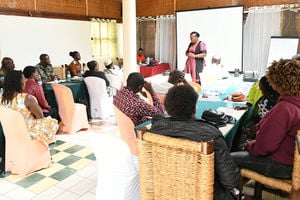
A woman inspects a female condom in Kampala yesterday. The female condom remains unpopular 26 years after it first hit the market in the country. Photo/Sylivia Katushabe
The female condom remains unpopular 26 years after it first hit the market in the country.
The purpose, its manufacturers say, is to prevent sexually transmitted infections (STIs), including HIV and unwanted pregnancies.
The first batch of female condoms arrived in Uganda in 1998; but to date, it remains unpopular and is only used by sex workers.
In August 2023, the Ministry of Health reintroduced an improved version of female condoms in an attempt to encourage higher uptake. However, several women interviewed by this newspaper said myths continue to frustrate the use of these condoms.
Some said the condoms make squeaky (embarrassing) sounds while being used while others expressed fear that the condoms could be pushed down their lady parts and cause harm.
“I fear using it again. That sound was embarrassing. For some reason, I feel like it will happen once I use it. I now ask my boyfriend to use a male condom instead,’’ Ms Beatrice Kyomuhendo, a student, said.
Several women still think condoms are meant for men and it is not right for a woman to wear it.
“If a man asked me to wear a condom, I would be offended. Condoms are made for men,” Ms Akot, not her real name, another student, said.
Coming from a patriarchal society, she said men make this kind of call. She said a man, as the head of the family, has to wear a condom and not a woman. Something Ms Regina Auma, a businesswoman, agreed with.
Esther, a sex worker, said there is a lot of misinformation about female condoms.
“At first, they told us that one can insert the female condom an hour before use. Also, the texture of the female condom has a funny roughness,” she said, adding that the rough texture can cause an injury to the private parts.
Esther also said given the nature of their business, the female condom wastes a lot of time and this means earning less than they would have without using it.
“Remember the more clients I get, the more money I get. If I am going to use a female condom, it means I have to take 30 minutes to insert it properly so that the client doesn’t make any mistakes,” she said.
“Sex work is not a thing of love, must keep the client’s time, unless you get a client who is willing to pay you for a night but also you have to take the client through the process of using a female condom,” she added.
Esther also said they are worried about the health implications. She thinks the rough texture is the reason for the squeaking sound. For this, Esther said she has stopped using female condoms and now encourages her clients to use male condoms.
“Under circumstances where these customers are not willing to wear condoms, the alternative is PrEP [pre-exposure prophylaxis], but the payment must be generous.”
“It depends on the money the client is willing to offer. Also the advantage that we have through the information we get (From AWAC, a sex workers-founded organisation), I am on PrEP so unprotected sex is okay but the money must be good,” she said.
Esther started using female condoms in 2014 but it was only for six months. In 2021, she got information that another brand of female condom was made better. She decided to try again but there was no change and in 2022 she stopped using them.
The high disapproval of female condom use by the most in-need population, namely the female sex workers, means the power of safe sex rests firmly in the hands of a man and his decision to use a condom.
This demands that condom industry players should engage with and incorporate suggestions from women for the design and manufacture of condoms to fit women’s preferences without discomfort for safe and pleasurable sex.
“If maybe they (manufacturers) can design something else like I will give an example. I have ever gone to Kenya, there was a female sex workers organisation that had a type of female condom that looked like a knicker, so you could put it on and it sticks on your body but the middle part looked like of a male condom,” she said.
She urged the government to borrow a leaf, saying “at least if the government can copy that, it’s okay”.
Female condoms are synthetic cylindrical closed-end devices made of synthetic or natural rubber. One end is open while the other end is closed.
They are placed in the female’s private part before intercourse, creating a barrier between the male genitalia and the female.
In Uganda, the HIV burden affects 1.4 million people, with 770,000 of them being women. Female condoms would provide vital protection to stem the rise in infections among women.
Female condoms were first put on the market as FC1 but were recalled as users complained they made squeaking sounds while being used. Something many found distracting, but would make a comeback as FC2 in October 2009. Despite enhancements in design and effectiveness, even the uptake of these female condoms remains low.
Low uptake explained
Dr Joel Lwasa, a gynaecologist at Kawempe National Referral Hospital in Kampala, said social stigma is the core reason for the low uptake of female condoms.

Several women still think condoms are meant for men and it is not right for a woman to wear it. Photo/File
He said a man will walk to the hospital and will freely ask for a condom but a woman cannot.
During our visit to Kawempe National Referral Hospital, we saw numerous expired female condoms on the shelf. Dr Lwasa said while the male condoms are usually bought off daily by midday, the female condoms take up to six months or even a year before they are taken.
He also said pervasive myths persist that female condoms can get lost in the female body or cause illness, the claim he said are unfounded.
Dr Lwasa said the uptake is still low because some women find inserting the condom challenging, requiring practice and additional lubrication. He also said the lack of sensation and odd sound made during use can also deter users.
“Information about the female condoms are not readily available let alone the condoms themselves. There are challenges of how to insert and the sound made at intercourse may not be as pleasant. Improve information and teaching how to use it. Also, encourage use despite their unpleasantness,” Dr Lwasa says.
How to increase uptake
Nonetheless, Dr Lwasa reassured that when used correctly, female condoms are up to 95 percent effective in preventing pregnancy and STIs, just like the male condoms.
He said the female condoms remain underused because of limited availability and misinformation. Dr Lwasa said many pharmacies and family planning clinics do not stock female condoms, making access difficult for many women.
For a solution, Dr Lwasa said aggressive advertising, community outreaches, and widespread availability to dispel the myths and encourage proper use can overcome this.
He said there are no known health risks apart from rare latex allergy. He said female condoms are not as common but should be available in family planning clinics and sold over the counter in pharmacies. He also said that female condoms don’t dull sensation and are not constricting like male condoms.
Mr Boniface Epoku, the condom focal person at the Ministry of Health, said they distribute 250 million condoms annually but only one percent of them are female condoms.
“Female condoms have been here since the early 2000s. FC1 was the first generation and had a bit of issues and we do a people-centred approach to condom programming that is to ensure we get feedback from the community on what is best for them. They said it was making noise and all that so we refined it; we came up with FC2, which is the second generation. This one is not made of rubber,” he says.
Mr Epoku said FC2 does not make noise because it is lubricated both inside and out. He also said the ministry has solutions in the pipeline to increase the uptake of these condoms. He said the preference for male condoms over the ones for females is because the population is not used to female condoms.
Men speak out
Monitor interviewed men on the matter and many were not okay with female condoms.
“Female condoms seem so wrong. I cannot have sex with a woman wearing a female condom. There is no intimacy. It feels like you are having sex with a rubber and not a human being,” Mr Ronald Oyo, a businessman, said.
Mr Denis Ssenyondo, a businessman, said he must first be convinced that it is comfortable.





